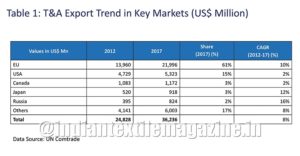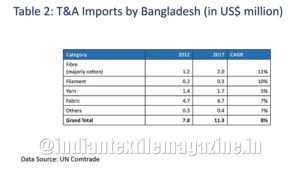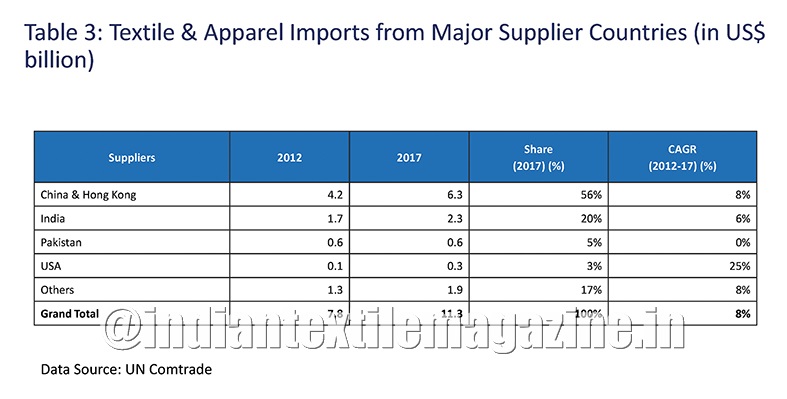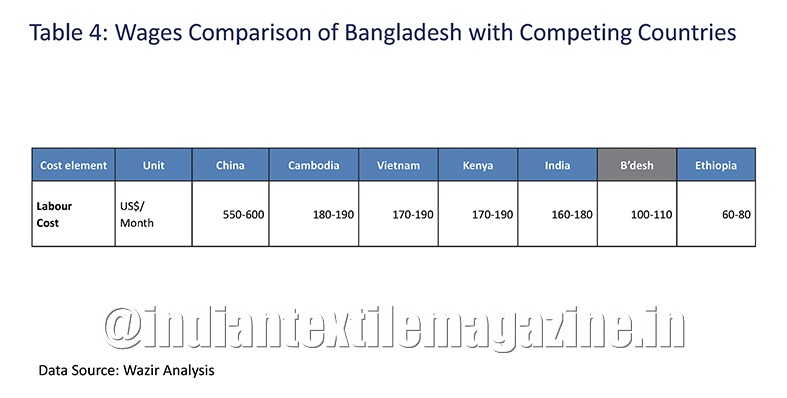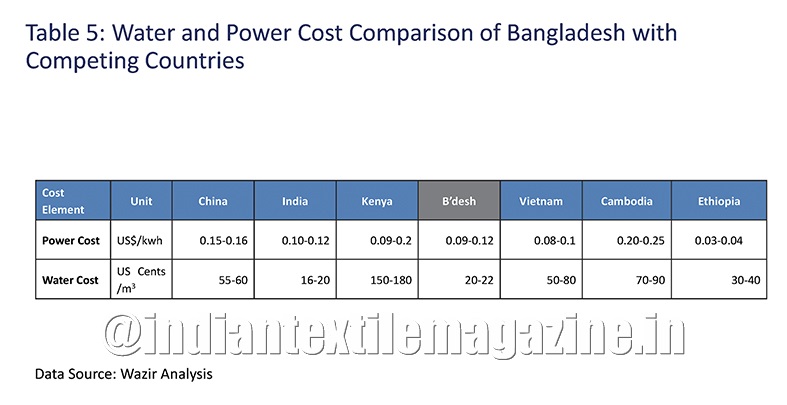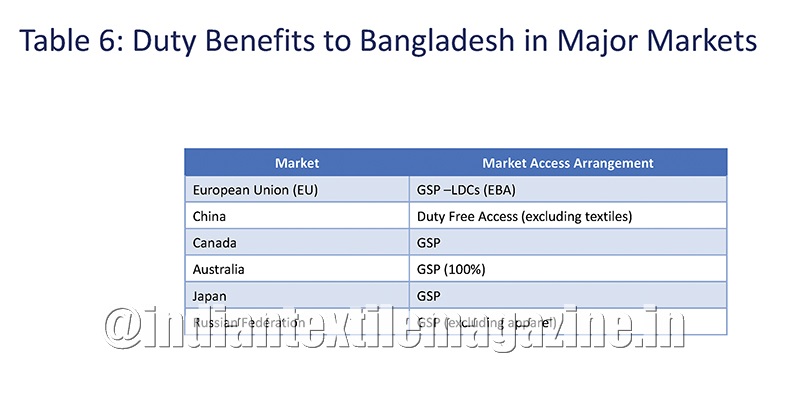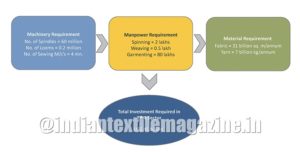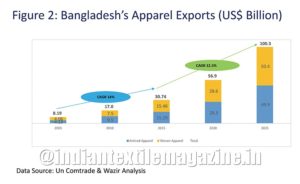In the last one decade, Bangladesh has emerged as a key garment supplier and at present it is the 2nd largest exporter of Readymade Garments (RMG) to the world after China. About 85% of Bangladesh’s export earning come from RMG sector. The growth of RMG sector has led to the commissioning of many new factories and generation of new employment opportunities. Bangladesh at present has around 4,500 operating garment factories which provides employment to about 4 million² people.
This article covers the garment trade scenario of Bangladesh, the various factors which has helped Bangladesh in emerging as key Garmenting hub, the challenges faced and how it can achieve $100 billion exports by 2025.
Bangladesh is a leading exporter of RMG showing double-digit exports growth
Bangladesh at present is the 2nd largest exporter of RMG after China. Its T&A exports have increased at a CAGR of 8% over last 5 years from $25 billion in 2012 to $36 billion in 2017. Bangladesh enjoys preferential access in the European Union (EU) under the ‘Everything but Arms’ (EBA) which has helped Bangladesh in gaining a commendable market share in EU. Today EU with a share of about 61% is the largest market for Bangladesh textiles products followed by the US with 15% share. A detailed analysis of Bangladesh exports to key markets over past 10 years indicate that other than EU and the US, the share of Japan and Russia has been increasing and is growing at a CAGR of 36% and 28%, respectively.
Bangladesh is still dependent on imports of fabric and yarn, however, it is focusing on setting up of large scale spinning and weaving factories
Though Bangladesh has emerged as leading supplier of RMG to world but it grows only 2% of its annual cotton requirement and imports remaining 98% of raw material in the form of cotton, yarn, fibre, filament and fabric. In 2017, Bangladesh imported T&A commodities worth $11.3 billion from world. With a share of about 60%, fabric forms the major share in total T&A imports followed by fibre and yarn with share of 18% and 15% respectively.
Duty free market access with China, makes it the largest supplier of T&A commodities to Bangladesh. It has a share of about 56% in total imports which has grown at a CAGR of ~8% during last 5 years. India and Pakistan are next top suppliers and together constitute around ~25% of Bangladesh’s total T&A import. T&A import from India has grown at a CAGR of 6% in the last 5 years.
However, it is noteworthy that during few years, increasing demand of fabric and yarn has made Bangladesh to invest heavily in the spinning and weaving sector. As per the data released by Bangladesh Textile Mills Association (BTMA), local entrepreneurs have invested an average of $165 million per year in the primary textile sector in last five years.
Government is also supporting FDI to further boost the textile sector. Many of the Chinese and South Korean companies are putting up spinning and weaving factories in collaboration with Bangladeshi entrepreneurs.
Lower production costs and supportive Government policies have helped Bangladesh in emerging as a manufacturing hub
Bangladesh has several advantages which has helped it to become the 2nd largest exporter of RMG to world. Various strengths are discussed below:
- Labour availability and low wages
Bangladesh is one of the most densely populated countries in the world. It has ample availability of cheap and vast workforce. In September 2019, the minimum wages in Bangladesh has increased, however it is still lower than that in China, Cambodia, India and Vietnam.
- Low power & water costs
Bangladesh has sufficient installed capacities of power, moreover, it’s cross border power trade agreements with countries like India ensures energy security. Water cost is also comparatively lower than competing countries like China, Ethiopia, Vietnam, Cambodia, etc.
Bangladesh enjoys benefits from the EU’s “Everything but Arms” arrangement, which grants duty free, quota free access for all exports, except arms and ammunition. Duty Free Quota Free (DFQF) status under EBA has increased Bangladesh’s apparel exports to EU from $7.0 billion in 2007 to $21.4 billion in 2017, grown at a CAGR of 12%. Bangladesh also has the Generalized System of Preferences (GSP) benefits for Canada and Turkey markets.
- Other advantages
Other advantages include Back-to-Back Letter of Credit facility, Bonded warehouse facilities, Single file clearance system, Export Processing Zones, Tax exemption for new factories, etc.
Bangladesh has a potential to reach $100 billion apparel exports by 2025
Bangladesh with its export competitiveness and duty free access has garnered significant attention from the international brands in recent years. Bangladesh’s apparel exports have grown at a CAGR of 14% since 2005 which makes it best performing country in terms of apparel export. Its exports are likely to grow at a CAGR of 12.5%, in future, which will lead to Bangladesh’s apparel exports becoming $100 billion by 2025.
To meet with the growing demand Bangladesh would require an investment of about $45 billion by 2025.
However, Bangladesh is facing many challenges which could affect its growth
Despite the growth shown by Bangladesh in RMG sector, many industrialists still worries about the growth prospect of Bangladesh. Major challenges which the industry is facing are listed below:
- Increasing wages: Low wages is one of the key advantage for Bangladesh. Economical labour cost in Bangladesh attracted many international brands from European and American markets to produce their products. However, Bangladesh is no longer the low cost destination as it used to be at the turn of century. Its labour cost has shown a significant increase recently and is likely to grow further in the future.
- Low productivity: The industry is facing various issues due to which efficiencies are also low, and losses are occurring in terms of yarn and fabric realization. The overall productivity levels in especially in apparel manufacturing are relatively low compared to its peers including China, Turkey, etc.
- Longer lead times: Bangladesh takes an average of 90-120 days to make final delivery while China takes 50-60 days.
- Increasing land and construction cost: Land price per katha (720 sq. ft.) in Dhaka has grown at an extraordinary pace of over 300% in the decade 2000 to 2010.
- High lending rates: The lending rates in Bangladesh are higher in comparison to China, India, Vietnam and Ethiopia which increase the cost of production and reduce product competitiveness.
- Emergence of other low cost manufacturing destinations like Ethiopia, Myanmar among others
Manufacturing excellence can help Bangladesh reach $100 billion garment exports
Bangladesh has a fragmented textile value chain. It is highly dependent on import of raw material for T&A commodities. Also, it is facing several other issues in terms of increasing wages, lower output, low product quality, etc. In order to remain competitive in the global market, Bangladesh need to focus on the below mentioned areas:
- Backward & forward integration
Bangladesh should focus on integration. It can help companies in gaining control over buyers, suppliers, distributors and customers. In addition, market power and position can be greatly enhanced through such vertical linkages within the industry. The benefits of such integration includes reduction of imports of fabric and yarn, internal consumption of products, value-addition at all stages of the textile value chain, reduction in costs, lead time reduction, increase in employment avenues for local population and better margins for the manufacturers.
It will also aid in long-term sustainability and guarantee survival in an intensely competitive industry.
- Manufacturing excellence
If Bangladesh has to be cost competitive in global markets, it has to focus on superior product quality, innovative design, customization, on-time delivery, technology innovations and finally admirable after-sales service. All these factors culminate into customer satisfaction. The ability to deliver on these parameters is what constitutes “Manufacturing Excellence”. This can be achieved through major transitions in manufacturing set-up and workforce development. The major components are as follows:
- Operational excellence
o Streamlining manufacturing operations: The requirement of streamlined manufacturing process stems from the need for high variety, low volume orders
o Quality and process improvement: Right First Time (RFT), Zero Defect (ZD), Quality Control (QC), etc., are concepts that point in the same direction-reduce variations and mishaps
o Capacity improvement: The key is that the operators need to start taking ownership of their equipment and the processes need to be simplified
o Information systems for operations and control: Information systems like Business Process Management (BPM) provide end-to-end solutions for any manufacturing unit.
- Manpower: Employee involvement is one the key components of employee retention in an industry which faces high level of attrition. The new age production processes demand employee involvement.
- Market intelligence: Since, the market environment is dynamic, market intelligence is required to keep up with the latest trends and new developments along with competitor analysis.
- Continuous improvement enablement:
o Operations re-engineering: It results in quality improvement, increased productivity and reduced manufacturing time and inventories.
o Product upgradation: There is a growing need for low-volume high fashion products.
o Skill development: There is need to train labour as well as middle management through proper training to build proper work culture.
o Focus on Indian market: Bangladeshi apparel manufacturers should focus on catering to the demand of Indian market which is expected to grow at 12% CAGR by 2025.
1 Bangladesh Export Promotion Bureau
2 Data released by Bangladesh Garment Manufacturers and Exporters Association (BGMEA)
By Sanjay Arora, Business Director, Anubha Sehgal, Senior Consultant, and Anmol Gupta, Associate Consultant, Wazir Advisors
